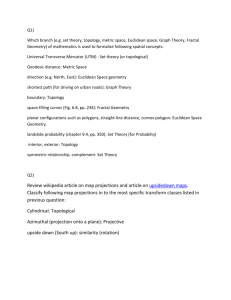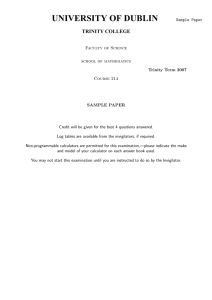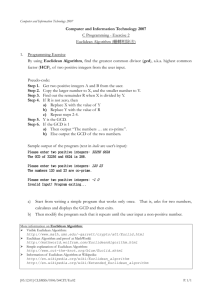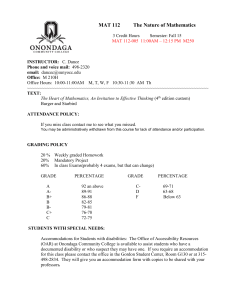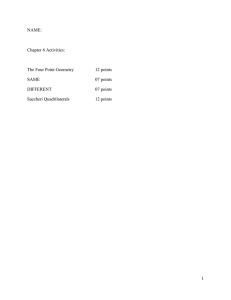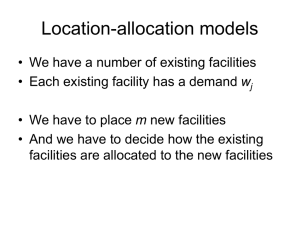On the regular polygons in the Chinese checker plane
advertisement
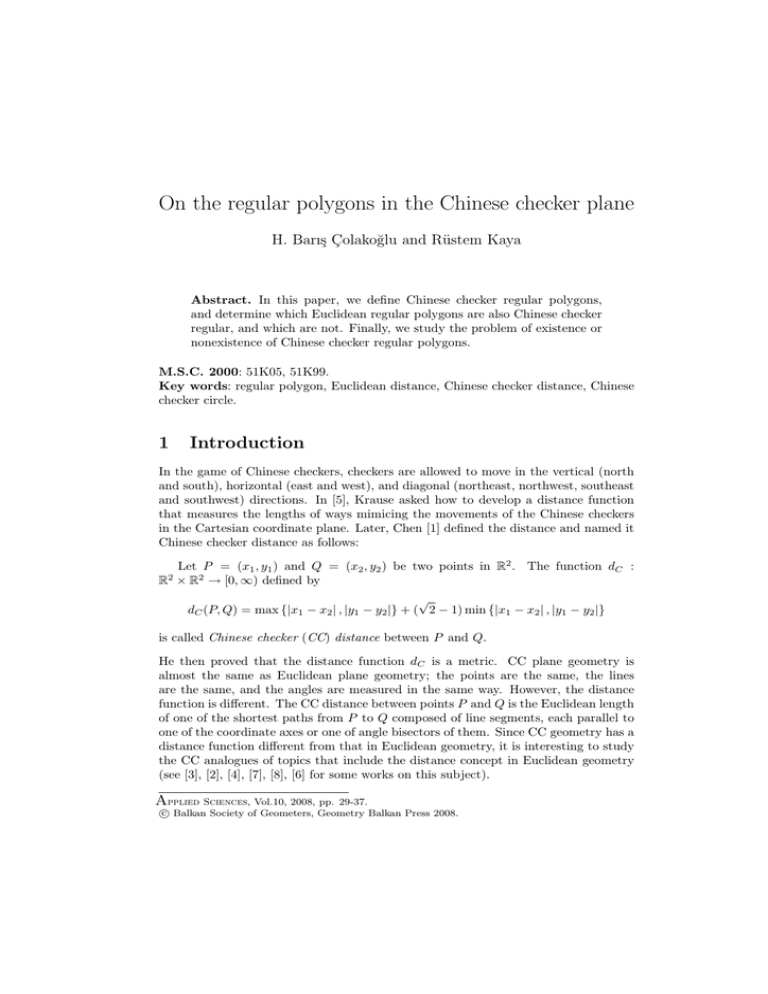
On the regular polygons in the Chinese checker plane
H. Barış Çolakoğlu and Rüstem Kaya
Abstract. In this paper, we define Chinese checker regular polygons,
and determine which Euclidean regular polygons are also Chinese checker
regular, and which are not. Finally, we study the problem of existence or
nonexistence of Chinese checker regular polygons.
M.S.C. 2000: 51K05, 51K99.
Key words: regular polygon, Euclidean distance, Chinese checker distance, Chinese
checker circle.
1
Introduction
In the game of Chinese checkers, checkers are allowed to move in the vertical (north
and south), horizontal (east and west), and diagonal (northeast, northwest, southeast
and southwest) directions. In [5], Krause asked how to develop a distance function
that measures the lengths of ways mimicing the movements of the Chinese checkers
in the Cartesian coordinate plane. Later, Chen [1] defined the distance and named it
Chinese checker distance as follows:
Let P = (x1 , y1 ) and Q = (x2 , y2 ) be two points in R2 . The function dC :
R × R2 → [0, ∞) defined by
2
√
dC (P, Q) = max {|x1 − x2 | , |y1 − y2 |} + ( 2 − 1) min {|x1 − x2 | , |y1 − y2 |}
is called Chinese checker (CC) distance between P and Q.
He then proved that the distance function dC is a metric. CC plane geometry is
almost the same as Euclidean plane geometry; the points are the same, the lines
are the same, and the angles are measured in the same way. However, the distance
function is different. The CC distance between points P and Q is the Euclidean length
of one of the shortest paths from P to Q composed of line segments, each parallel to
one of the coordinate axes or one of angle bisectors of them. Since CC geometry has a
distance function different from that in Euclidean geometry, it is interesting to study
the CC analogues of topics that include the distance concept in Euclidean geometry
(see [3], [2], [4], [7], [8], [6] for some works on this subject).
Applied Sciences, Vol.10, 2008, pp.
29-37.
c Balkan Society of Geometers, Geometry Balkan Press 2008.
°
30
2
H. Barış Çolakoğlu and Rüstem Kaya
CC regular polygons
As in the Euclidean plane, a polygon in the CC plane consists of three or more
coplanar line segments; the line segments (sides) intersect only at endpoints; each
endpoint (vertex) belongs to exactly two line segments; no two line segments with a
common endpoint are collinear. If the number of sides of a polygon is n (n > 3,n ∈ N),
then the polygon is called an n-gon. The following definitions for the polygons in the
CC plane are given by means of the CC lengths instead of the Euclidean lengths:
Definition 1 A polygon in the plane is called CC equilateral if the CC lengths of its
sides are equal.
Definition 2 A polygon in the plane is called CC equiangular if the measures of its
interior angles are equal.
Definition 3 A polygon in the plane is called CC regular if it is both CC equilateral
and CC equiangular.
Definition 2 does not give a new equiangular concept because the CC and the
Euclidean measure of an angle are the same. That is, every Euclidean equiangular
polygon is also CC equiangular, and vice versa. However, since the CC plane has a
different distance function, Definition 1 and therefore Definition 3 are new concepts.
In this study, we determine which Euclidean regular polygons in the plane are also
CC regular, and which are not. We also investigate the existence and nonexistence of
CC regular polygons.
It is known that a rotation
of θ radians around ªa point preserves the CC
©
distance if and only if θ ∈ tπ
+
2kπ
: 0 ≤ t ≤ 7, t, k ∈ Z , and a reflection about the
4
line © ax + by√ + c =√ 0 preserves
the CC distance if and only if
ª
a
2
−
1),
±(
2
+
1)
or
b
=
0
(see [4]). Let us denote by S the set of
∈
0,
±1,
±(
b
√
√
√
lines x = 0 √
, y = 0, y = x, y = −x, y = ( 2 − 1)x, y = −( 2 − 1)x, y = ( 2 + 1)x,
and y = −( 2 + 1)x. Then one can immediately state following:
Lemma 1. Let A, B, and C be three non-collinear points in the Cartesian plane such
that dE (A, B) = dE (B, C). Then dC (A, B) = dC (B, C) if and only if the measure of
the angle ABC is π/4, π/2 or 3π/4, or A and C are symmetric about the line through
B and parallel to a line in S.
3
Euclidean regular polygons in the CC plane
Since every Euclidean regular polygon is also CC equiangular, it is obvious that a
Euclidean regular polygon is CC regular if and only if it is CC equilateral. Therefore, to investigate the CC regularity of a Euclidean regular polygon, it is sufficient
to determine whether it is CC equilateral or not. In doing so, we use following concepts: Any Euclidean regular polygon can be inscribed in a circle, and a circle can be
circumscribed about any Euclidean regular polygon. A point is called the center of
a Euclidean regular polygon if it is the center of the circle circumscribed about the
polygon. A line l is called axis of symmetry of a polygon if the polygon is symmetric
about l, and in addition, if l passes through a vertex of the polygon then l is called
On the regular polygons in the Chinese checker plane
31
radial axis of symmetry of the polygon. Clearly, every axis of symmetry of a Euclidean
regular polygon passes through the center of the polygon.
Now, we are ready to investigate the CC regularity of Euclidean regular polygons.
The following three propositions determine Euclidean regular polygons that are also
CC regular.
Proposition 1. Every Euclidean regular quadrilateral (Euclidean square) is CC regular.
Proof. Since every side of the Euclidean square has the same Euclidean length
and the angle between every two consecutive sides is a right angle (see Figure 1), by
Lemma 1, every side has the same CC length. Therefore, every Euclidean square is
CC equilateral, and therefore is CC regular.
¤
Figure 1
Proposition 2. Every Euclidean regular octagon is CC regular.
Proof. Since every side of the Euclidean regular octagon has the same Euclidean
length and the measure of the angle between every two consecutive sides is 3π/4
radians (see Figure 2), by Lemma 1, every side has the same CC length. Therefore,
every Euclidean regular octagon is CC equilateral, and therefore is CC regular. ¤
Figure 2
Proposition 3. Every Euclidean regular 16-gon, one of whose radial axes of symmetry is parallel to a line in S, is CC regular.
Proof. Clearly, every Euclidean regular 16-gon has eight radial axes of symmetry,
and if one of them is parallel to a line in S, then each of the other radial axes of
symmetry is parallel to a line in S, too (see Figure 3). Since every two consecutive
sides of such a Euclidean regular 16-gon are symmetric about a line parallel to a line
in S, and every side has the same Euclidean length, by Lemma 1, these sides have
the same CC length. Thus a Euclidean regular 16-gon, one of whose radial axes of
symmetry is parallel to a line in S, is CC equilateral, and therefore is CC regular. ¤
32
H. Barış Çolakoğlu and Rüstem Kaya
Figure 3
Following theorem states that there is no other Euclidean regular polygon that is
also CC regular.
Theorem 4. No Euclidean regular polygon, except the ones in Proposition 1, Proposition 2 and Proposition 3, is CC regular.
Proof. Let us consider first a Euclidean regular n-gon such that n 6= 4, n 6= 8,
and n 6= 16. Then the measure of the angle between any two consecutive sides of
the n-gon, π(n − 2)/n, is not π/4, π/2 or 3π/4 radians. Clearly, the measure of the
angle between two lines each of which is parallel to a line in S is a multiple of π/8
radians. Since the measure of the angle between any two consecutive radial axes of
symmetry of the n-gon, 2π/n, is not a multiple of π/8 radians, one of those radial axes
of symmetry is not parallel to any line in S. Therefore, there exist two consecutive
sides which are symmetric to each other about a line not parallel to any line in S,
and the angle between them is not π/4, π/2, or 3π/4 radians. These sides have not
the same CC length, by Lemma 1. Thus the n-gon is not CC regular. Let us consider
now a Euclidean regular 16-gon, one of whose radial axes of symmetry is not parallel
to any line in S. Clearly, the measure of the angle between two consecutive sides of
the 16-gon is 7π/8 radians, and none of the radial axes of symmetry is parallel to a
line in S. Then there exist two consecutive sides which are symmetric to each other
about a line not parallel to any line in S, and the angle between them is not π/4,
π/2, or 3π/4 radians. These sides have not the same CC length, by Lemma 1. Thus
the 16-gon, one of whose radial axes of symmetry is not parallel to any line in S, is
not CC regular. The proof is completed.
¤
4
Existence of CC regular 2n-gons
We know now that which Euclidean regular polygons are CC regular, and which are
not. Furthermore, we also know existence of some CC regular polygons. However,
we do not have general knowledge about the existence of CC regular polygons. The
following theorem shows the existence of CC regular 2n-gons, using CC circles. Recall
that a CC circle with center A and radius r is the set of all points whose CC distance
to A is r. This locus of points is a Euclidean regular octagon, one of whose radial
axes of symmetry having slope 0. Just as for a Euclidean circle, the center A and one
point at a CC distance r from A completely determine the CC circle.
On the regular polygons in the Chinese checker plane
33
Theorem 5. There exist two congruent CC regular 2n-gons (n ≥ 2) having given
any line segment as a side.
Proof. Clearly, the measure of each interior angle of an equiangular 2n-gon (n ≥ 2)
is π(n − 1)/n radians. Let us consider now any given line segment A1 A2 in the CC
plane. It is obvious that (n − 1) line segments Ai Ai+1 , 2 ≤ i ≤ n, having the same
CC length with A1 A2 can be constructed using the CC circles with center Ai and
radius dC (A1 , A2 ), such that the measure of the angle between every two consecutive
segments is π(n − 1)/n radians (see Figure 4). Also it is not difficult to see that
]A2 A1 An+1 + ]An An+1 A1 = π(n − 1)/n when these line segments are constructed.
Figure 4
Figure 5
If we continue to construct line segments A0i A0i+1 , 1 ≤ i ≤ n, which are symmetric
to Ai Ai+1 about the midpoint of A1 An+1 , respectively, we get a 2n-gon (see Figure 5). Since the symmetry about a point (rotation of π radians around a point)
preserves both the CC distances and the angle measures, we have dC (Ai , Ai+1 ) =
dC (A0i , A0i+1 ) = dC (A1 , A2 ) for 1 ≤ i ≤ n, and ]Ai = ]A0i = π(n−1)/n for 2 ≤ i ≤ n.
Also it is easy to see that ]A1 = ]An+1 = π(n − 1)/n. Thus, the constructed 2n-gon
is CC regular. Furthermore, on the other side of the line A1 A2 , one can construct
another CC regular 2n-gon, having the same line segment A1 A2 as a side, using the
same procedure (see Figure 6). However, it is easy to see that these two CC regular
2n-gons are symmetric about the midpoint of the line segment A1 A2 , and congruent.
¤
34
H. Barış Çolakoğlu and Rüstem Kaya
Figure 6
In any CC regular 2n-gon, there are n line segments joining the corresponding
vertices of the 2n-gon (Ai A0i , 1 ≤ i ≤ n, for the polygon in Figure 5 and Figure 6).
We call each of these line segments axis of the polygon. Clearly, axes of any CC
regular 2n-gon intersect at one and only one point.
Example Using the procedure given in the proof of Theorem 5, one can easily construct CC regular 2n-gons having given any line segment as a side. For example, we
construct a CC regular quadrilateral (CC square), a CC regular hexagon and a CC
regular octagon, having given line segment A1 A2 as a side, in Figure 7, 8 and 9:
Figure 7
5
Figure 8
Figure 9
More about CC regular 2n-gons
We know by Proposition 1 and Proposition 2 that every Euclidean square and Euclidean regular octagon are CC regular. By Proposition 6 and Proposition 7, we
see that every CC square and CC regular octagon are also Euclidean regular. The
following lemma is another statement of Lemma 1:
Lemma 2. Let A, B, and C be three non-collinear points in the Cartesian plane such
that dC (A, B) = dC (B, C). Then dE (A, B) = dE (B, C) if and only if the measure of
the angle ABC is π/4, π/2 or 3π/4, or A and C are symmetric about the line through
B and parallel to a line in S.
The following three propositions determine CC regular polygons that are also
Euclidean regular.
On the regular polygons in the Chinese checker plane
35
Proposition 6. Every CC square is Euclidean regular.
Proof. Since every side of the CC square has the same CC length and the angle
between every two consecutive sides is a right angle, by Lemma 2, every side has
the same Euclidean length. Therefore, every CC square is Euclidean equilateral, and
therefore is Euclidean regular.
¤
Proposition 7. Every CC regular octagon is Euclidean regular.
Proof. Since every side of the CC regular octagon has the same CC length and
the measure of the angle between every two consecutive sides is 3π/4, by Lemma 2,
every side has the same Euclidean length. Therefore, every CC regular octagon is
Euclidean equilateral, and therefore is Euclidean regular.
¤
We need a new notion to prove the next proposition: An equiangular polygon with
an even number of vertices is called equiangular semi-regular if sides have the same
Euclidean length alternately. There is always a Euclidean circle passing through all
vertices of an equiangular semi-regular polygon (see [9]).
Proposition 8. Every CC regular 16-gon, one of whose axes is parallel to a line in
S, is Euclidean regular.
Proof. In every CC regular 16-gon, since the measure of the angle between any
two alternate sides is 3π/4 and sides have the same CC length, by Lemma 2, sides
have the same Euclidean length alternately. Therefore, every CC regular 16-gon
is equiangular semi-regular. It is obvious that if any two consecutive sides of an
equiangular semi-regular polygon have the same Euclidean length, then the polygon
is Euclidean regular. Let us consider a CC regular 16-gon, A1 A2 ...A16 , one of whose
axes, let us say A1 A9 , is parallel to y = 0, for one case (see Figure 10). Then there
exist a Euclidean circle with diameter A1 A9 , passing through points A1 , A2 , ..., A16 ,
and there exist a CC circle with center A1 , passing through points A2 and A16 .
Since the Euclidean and the CC circles are both symmetric about the line A1 A9 , the
intersection points of them, A2 and A16 , are also symmetric about the same line. Then
two consecutive sides A1 A2 and A1 A16 have the same Euclidean length. Therefore,
the CC regular 16-gon, one of whose axes is parallel to the line y = 0, is Euclidean
regular. The other cases are similar.
¤
Figure 10
36
H. Barış Çolakoğlu and Rüstem Kaya
Following theorem states that there is no other CC regular polygon that is also
Euclidean regular.
Theorem 9. No CC regular polygon, except the ones in Proposition 6, Proposition
7 and Proposition 8, is Euclidean regular.
Proof. Assume that there exists a CC regular polygon, except the ones in Proposition 6, Proposition 7 and Proposition 8, that is also Euclidean regular. Then there
exists a Euclidean regular polygon, except the ones in Proposition 1, Proposition 2
and Proposition 3, that is also CC regular. But this is in contradiction with Theorem
4. Therefore, no CC regular polygon, except the ones in Proposition 6, Proposition 7
and Proposition 8, is Euclidean regular.
¤
Consequently, in the CC plane, squares and regular octagons have invariable
shapes which are the same as those in the Euclidean plane, and they are the only
polygons having this property.
6
On the nonexistence of CC (2n − 1)-gons
The following proposition shows the nonexistence of CC regular triangle:
Proposition 10. There is no CC regular triangle.
Proof. Every CC equiangular triangle is Euclidean regular. Since no Euclidean
regular triangle is CC regular by Theorem 4, no CC equiangular triangle is CC regular.
Therefore, there is no CC regular triangle.
¤
Unfortunately, we could not reach any conclusion by reasoning about the existence
or nonexistence of CC regular (2n − 1)-gons for n ≥ 3. However, we have seen that
there is no CC regular 5-gon, 9-gon and 15-gon using a computer program called
C.a.R (Compass and Ruler) (see [10]). Our conjecture is that there is no CC regular
(2n − 1)-gon. It seems interesting to study the open problem: “Does there exist any
CC regular (2n − 1)-gon?”
References
[1] G. Chen, Lines and Circles in Taxicab Geometry, Master Thesis, Department of
Mathematics and Computer Science, Centered Missouri State University, 1992.
[2] Ö. Gelişgen, R. Kaya, CC-Analog of the Theorem of Pythagoras, Algebras Groups
Geom., 23 (2006), 179-188.
[3] Ö. Gelişgen, R. Kaya, M. Özcan, Distance Formulae in the Chinese Checker
Space, Int. Jour. of Pure and Appl. Math. (IJPAM), 26 (2006), 35-44.
[4] R. Kaya, Ö. Gelişgen, S. Ekmekci, A. Bayar, On the Group of Isometries of
CC-Plane, Missouri J. of Math. Sci., 18 (2006), 221-233.
[5] E.F. Krause, Taxicab Geometry, Addision-Wesley, Menlo Park, California (1975).
[6] M. Turan, M. Özcan, General Equation for Chinese Checker Conics and FocusDirectrix Chinese Checker Conics, Int. Jour. of Pure and Appl. Math. (IJPAM),
30 (2006), 397-406.
On the regular polygons in the Chinese checker plane
37
[7] M. Turan, M. Özcan, Two-foci Chinese Checker Ellipses, Int. Jour. of Pure and
Appl. Math. (IJPAM), 16 (2004), 119-127.
[8] M. Turan, M. Özcan, Two-foci Chinese Checker Hyperbolas, Int. Jour. of Pure
and Appl. Math. (IJPAM), 16 (2004), 509-520.
[9] ——, http://eom.springer.de/p/p073580.htm ; Encyclopaedia of Mathematics,
Springer-Verlag, (2002).
[10] ——,
http://mathsrv.ku-eichstaett.de/MGF/homes/grothmann/java/zirkel
/doc en/index.html.
Authors’ address:
H. Barış Çolakoğlu
Eskişehir Osmangazi University, Faculty of Arts and Sciences,
Department of Mathematics, 26480, Eskişehir, Turkey.
E-mail: bariscolakoglu@hotmail.com, rkaya@ogu.edu.tr

